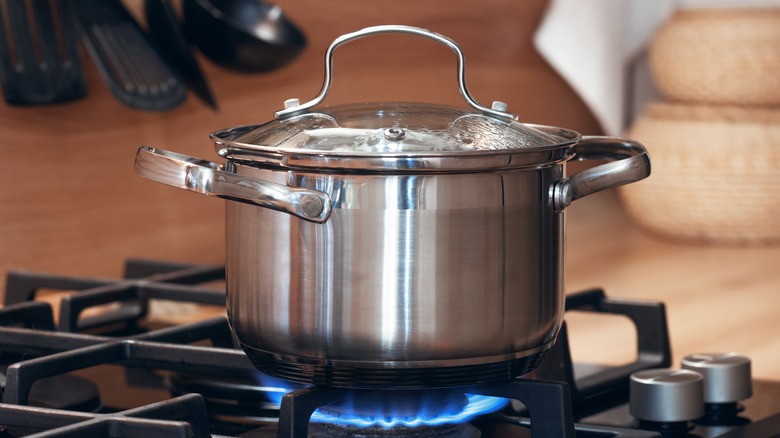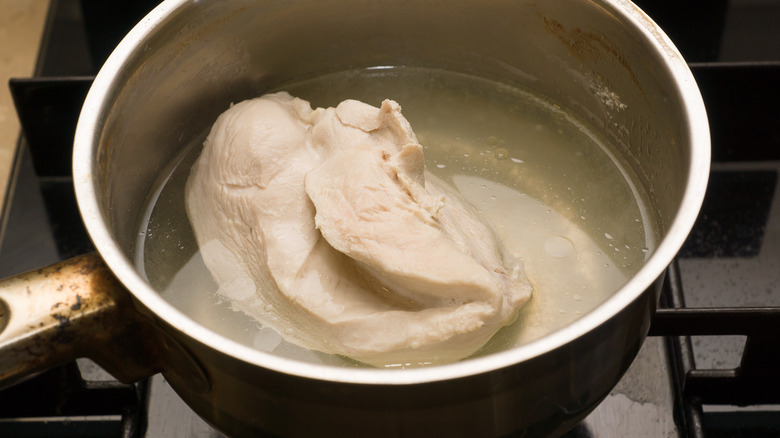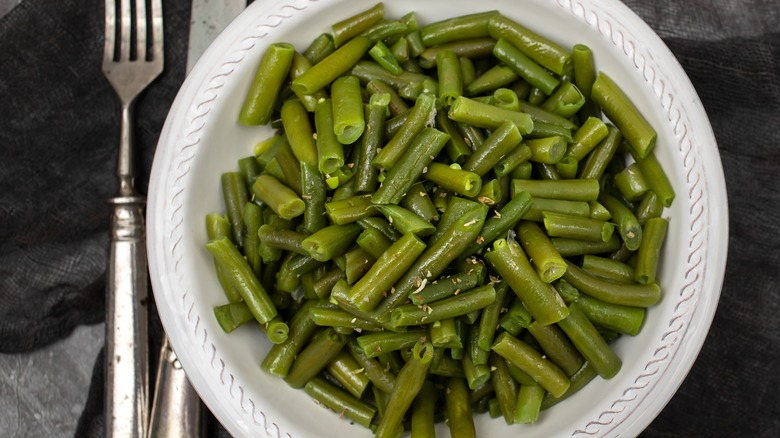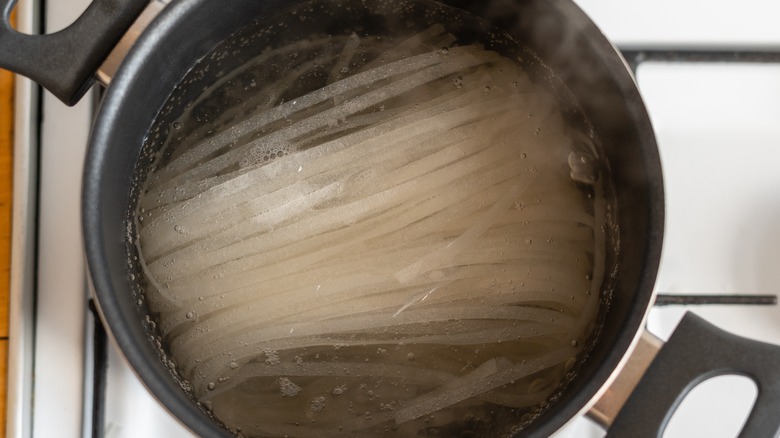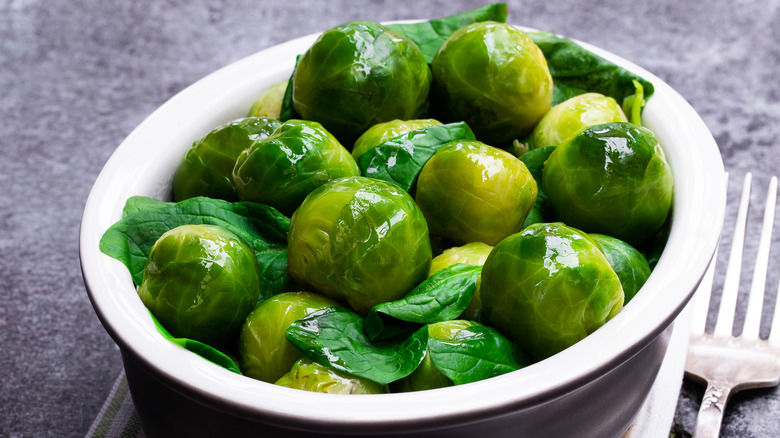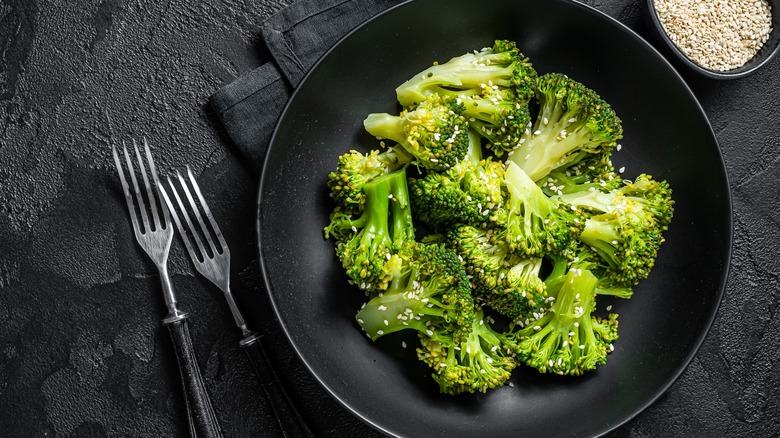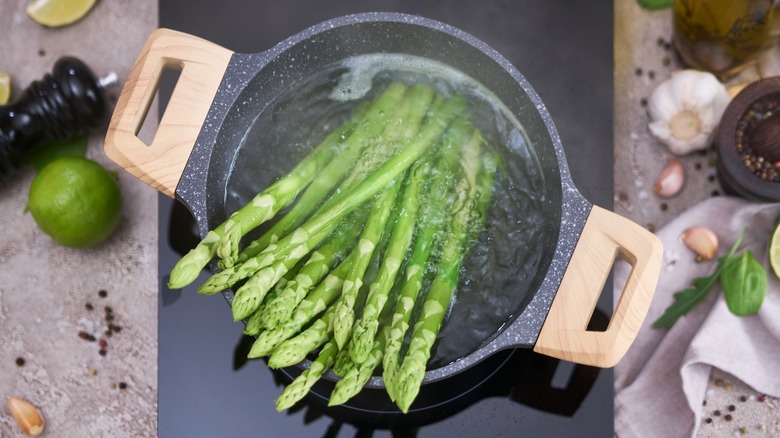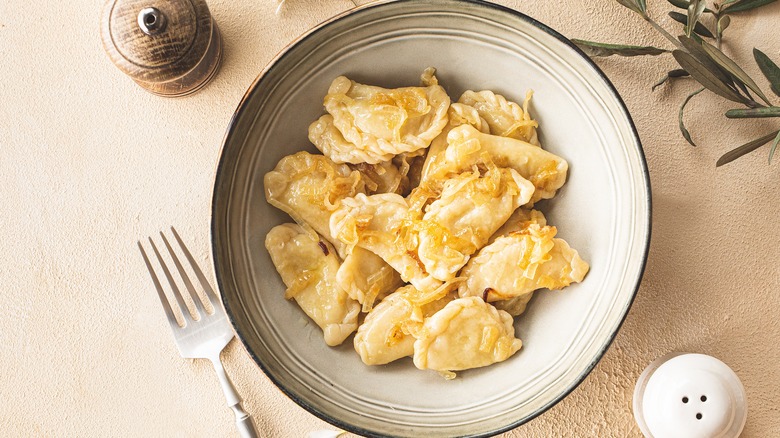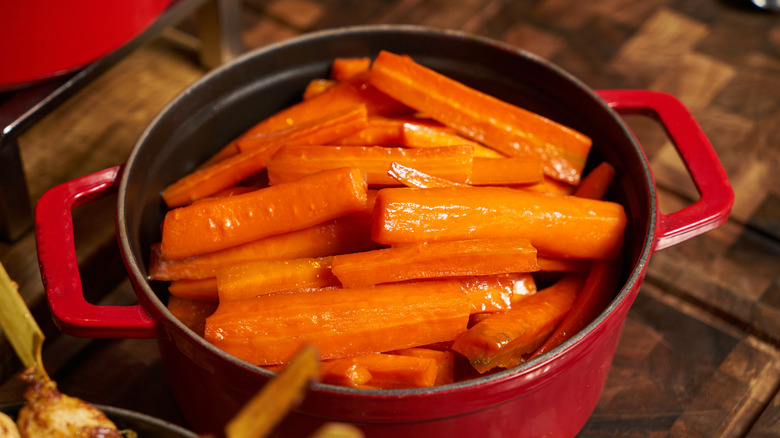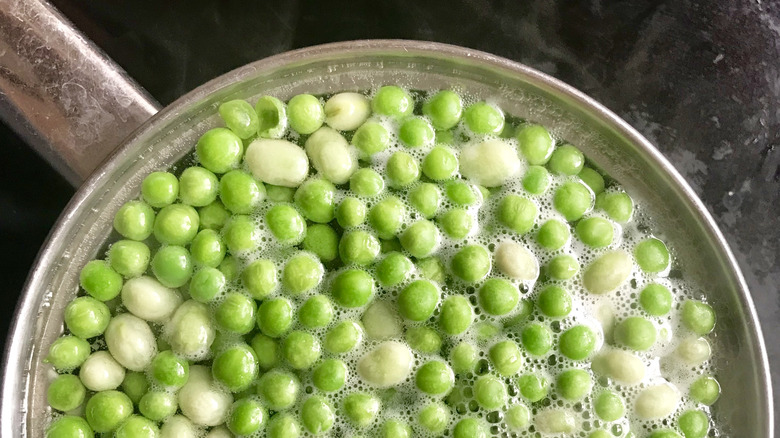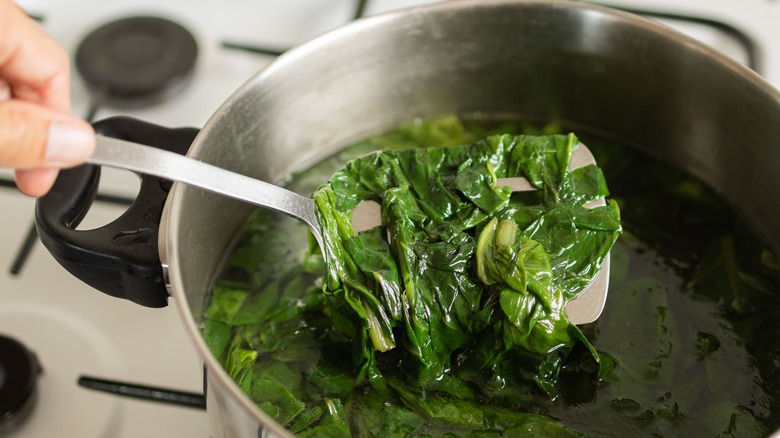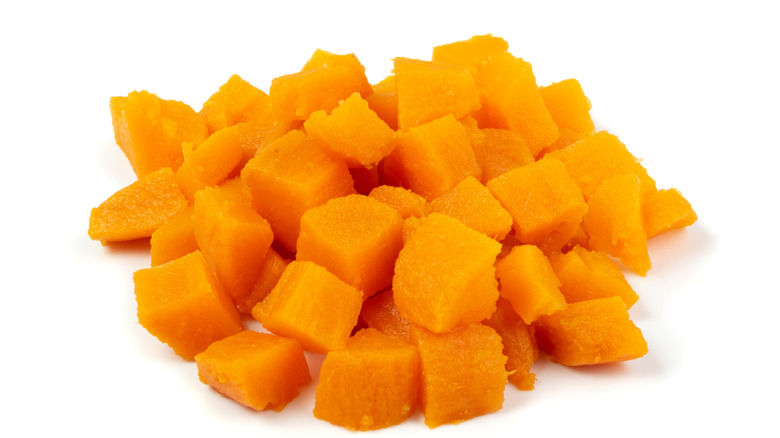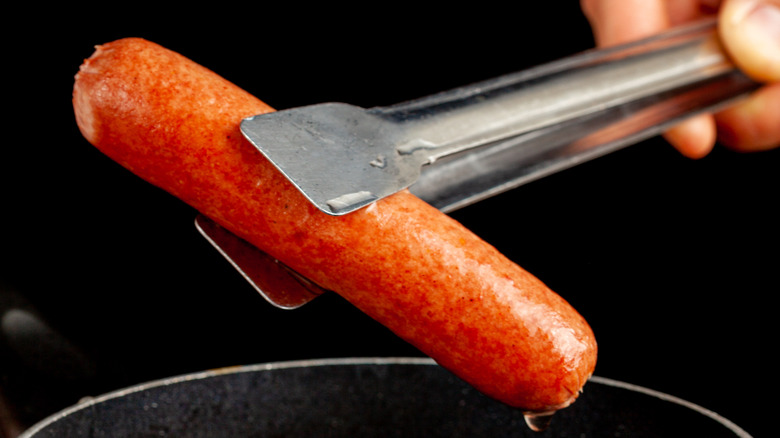12 Foods You Should Probably Stop Boiling
There was a time when most food could only be prepared in a few ways: fresh, cooked in flames, or boiled. But of course, that was also tens of thousands of years ago, when early humans were first figuring out the basics of primitive cooking. And a lot has obviously changed in that time.
Still, boiling foods does have benefits beyond its basic function of killing harmful illness-triggering microorganisms and parasites — and those good things about the practice carry over to this day. For example, boiling makes some tough or fibrous foods more palatable and easier to chew and digest. It also allows for the extraction of flavors from ingredients like bones, herbs, and spices, enhancing the taste of certain dishes.
Yet at the same time, those pluses tend to be outweighed by the numerous drawbacks that come with dropping something you want to eat into a vat of boiling water. Boiling can leach water-soluble nutrients out of foods, per Healthline. It can also turn some foods tough and others into mush. And perhaps worst of all, most boiled foods end up extremely bland — the ultimate hospital food without any taste. So while you should keep boiling pasta, beans, and rice — and maybe the occasional hard-boiled egg — most other foods are much tastier when cooked in other ways, such as sautéing, roasting, and grilling.
If you're still boiling the dozen foods on this list, it's probably time to stop and move on to a better — and tastier — alternate technique.
1. Chicken
Chicken noodle soup is a classic cold-weather comfort food that can make anyone feel happier and healthier, even if you weren't under the weather to start with. And one of the oldest techniques around for making the soup can involve dropping a whole chicken or some chicken pieces into a pot of hot water with onions and herbs and letting everything simmer until soft and tender and the meat is falling from the bone.
That technique is fine if you have the time — and you enjoy chicken that is slightly rubbery, bland, and stringy. But whether you're making soup, stew, or chili, there are far better ways to cook your chicken for these dishes rather than boiling it.
For example, you might roast your chicken to golden perfection in the oven and then shred that meat up to use in your recipe instead. Or pan-sear your chicken breast or thighs in a hot skillet with butter or olive oil until delightfully crispy and then dice and use in the dish. Or maybe just pick up a rotisserie chicken from the market and use that meat. Each of these options is faster — and tastier — and will provide you with a better quality dish than pale, bland boiled chicken ever could.
2. Green beans
Boiling green beans is a cooking technique that has persisted for years — but it's also one that needs to be retired. As those beans simmer in hot water, vital nutrients dissolve into the cooking liquid, leaving limp, overcooked shells of what were formerly crisp and bright green veggies in their place.
To make the most of your green beans, find a better way to prepare them — you have many different options. Steaming green beans, for instance, is an ideal way to maintain their bright green color, crisp texture, and nutritional content while achieving just the right level of tenderness. Sautéing green beans in a hot skillet with garlic and a dash of olive oil is another great technique that results in beans with a delightful combination of caramelization and crunch.
Whichever technique you choose, just don't let your beans cook too long. For both steaming or sautéing, you want your green beans to reach a state known as tender-crisp — when they are tender and easy to bite into, yet still retain a slight firmness or snap when you take a bite. This usually requires about 4 to 6 minutes of cooking time, max.
Once your beans are cooked, highlight their flavor even more with a sprinkle of toasted almonds, a squeeze of lemon juice, or a drizzle of balsamic vinegar for an extra layer of taste. You'll never go back to stringy, watery, boiled green beans again.
3. Rice noodles
Boiling rice noodles is easy, but it might not be the best choice when it comes to preserving the flavor and texture of this versatile staple. For starters, when boiling rice noodles, you are immediately at risk of overcooking your dish. That's because rice noodles can go from perfectly tender to mushy in a matter of seconds when submerged in boiling water.
Boiling rice noodles for too long can cause them to clump and stick together during the cooking process. Worst of all, boiling rice noodles robs these tasty, chewy treats of their flavor — they just end up bland and underwhelming compared to noodles that have been cooked in other ways.
Instead of boiling, consider the wonders of stir-frying. It allows you to infuse the noodles with savory soy sauce or fragrant curry. Simply soak the rice noodles in hot water until pliable and then add them directly to your skillet or wok and toss well with your other ingredients as you bring everything to an even temperature and finish cooking the noodles. This is an ideal option if you are making Pad Thai or Drunken Noodles and want your noodles to maintain as much chew and texture as possible.
4. Brussels sprouts
If you grew up believing you hated Brussels sprouts, the reason is probably that your mom bought them frozen and then boiled them, creating something most kids — and adults — can't stand. But that's a shame, because with the right preparation, Brussels sprouts don't have to be mushy, waterlogged, unappetizing globs of bitterness.
To help these cruciferous gems really shine, you've got to prepare them in other ways that better complement their unique flavor and texture. Roasting Brussels sprouts in the oven with olive oil, salt, and pepper can enhance their cabbage-like flavor wonderfully, imparting a delicious caramelized sweetness and a satisfying crispy crunch. Pan-searing Brussels sprouts with butter or bacon is another great technique for making these sprouts crunchy and pleasantly charred. You can even prepare Brussels sprouts in an air fryer. The final product packs a nutty, earthy quality you'd never find in boiled Brussels.
To serve a plate of these green globes once they're cooked, consider adding a drizzle of balsamic glaze, a sprinkle of Parmesan cheese, or a handful of toasted nuts for extra texture and flavor. It's a side so satisfying, you'll wonder how you could have ever hated them in the first place.
5. Broccoli
Like Brussels sprouts, the worst thing you could ever do when preparing these cruciferous greens is drop them into a pot of boiling water. Besides stripping away valuable nutrients, boiling leaves even the freshest, highest quality broccoli a sad, soggy, mushy mess.
To make your broccoli as delicious as possible, steaming is a much better option. Just place your fresh or frozen florets in a steamer basket over boiling water, cover, and let cook for 5 to 6 minutes. The broccoli is done when it is just tender enough to eat without seeming too crunchy.
Roasting broccoli in the oven with a drizzle of olive oil, garlic, and spices like paprika, red pepper flakes, thyme, rosemary, or cumin is another great way to prepare the veggie. You'll end up with broccoli that's a delight to eat — loaded with caramelized flavor and crispy, charred edges.
Don't turn your back on stir-frying as an option either, even if you're just preparing broccoli on its own. Add a dash of soy sauce or sesame oil, cook until tender, and then garnish with grated Parmesan cheese, lemon zest, or toasted almonds.
6. Asparagus
Asparagus is a magical vegetable. You find it in nature growing next to farm fences or hidden in the grass near a bubbling spring. It's earthy, clean, and a little grassy, with a mild sweetness that's almost floral or herbaceous. The stalk is crisp and tender and unlike almost any other vegetable you eat. It truly is the "king of vegetables," as many have dubbed it.
But all that goes away when you boil asparagus instead of cooking it in another way. Boiled asparagus is limp; it's stringy; and it can end up virtually flavorless — the longer you cook it, the more that delicate, unique flavor hidden in the stalks simply seeps away.
To fully embrace the true potential of fresh (or frozen) asparagus and all it has to give, consider roasting instead of boiling. Preheat your oven to 425 degrees Fahrenheit, toss the spears in olive oil, sprinkle with salt and pepper, and then let those spears roast for about 10 to 15 minutes until they're tender and slightly caramelized. Or, take your asparagus to the grill. Simply brush the spears with olive oil, season to taste, and grill for about 5 minutes, turning occasionally until they are tender and sport some of those beautiful grill marks we all love (You may want to consider using a grill mat to keep those spears from falling into the flames below as they cook).
7. Pierogies
For those who've never had a chance to try them before, pierogies are classic dumplings that originated in Eastern Europe. These tender, tasty pockets are made from dough that is rolled out and filled with everything from mashed potatoes and cheese to sauerkraut, mushrooms, and even ground beef. Once filled, the dough is folded over and sealed. Traditionally, fresh or frozen pierogies are boiled before they are served. This process warms the filling and cooks the dough, creating a treat that is loved around the world.
But the process isn't perfect. Boiled pierogies tend to absorb excess water, causing them to become bloated and overly soft. Filling can leak out and their flavor can turn, becoming muddled and almost chalky at times as the taste of wet dough blends with runny potato.
To avoid the problem, it's better to treat pierogies just like any other type of dumpling you love and pan fry them instead. Simply heat a skillet with butter or oil, add your pierogies (thawed if using frozen), and cook until they develop a golden-brown crust on both sides (usually about 2 to 3 minutes per side). Pan frying not only keeps pierogies from becoming too damp, but it also gives that outer dough an incredible crispy exterior — crisp and crunchy on the outside and nice and soft inside thanks to that pillowy potato. Add some caramelized onions and a dollop of sour cream and you've got a wonderful side or a simple single-pan meal.
8. Carrots
Carrots are one of the most nutritious veggies around, filled with nutrients like Vitamin A, potassium, and iron. But research shows that more than half of those nutrients can be lost when you cook carrots in boiling water instead of using other culinary methods to prepare them for a meal (via Sutter Health). On top of that nutritional loss, boiling also saps carrots of their natural crispness and vibrancy, turning them into gloppy orange blobs.
To prepare carrots in a much tastier — and more nutritious — way, consider roasting them instead. It takes approximately the same amount of time and yields infinitely more delicious results. Just toss your fresh carrots in olive oil, season them with herbs like rosemary, dill, thyme, or parsley, and then roast at 425 degrees Fahrenheit for about 20 to 25 minutes or until they're tender and caramelized. Sautéing carrots in a hot pan with butter or oil is another delicious option. It lets you create a satisfying side with a tender yet slightly crunchy texture that's still packed with the natural sweetness carrots are known for. Want an even greater kick of flavor? Add a bit of honey, ginger, or balsamic vinegar to your carrots as they cook.
9. Peas
Peas just fall apart when exposed to boiling water for even a relatively short period of time. To avoid this sort of culinary disaster, try steaming your peas as an alternative. Whether fresh or frozen, the process generally only takes around 6 minutes and will be much better for helping to preserve both the vibrant gem-like color of the peas as well as their sweet, natural flavor. Or, you might also consider sautéing peas in a bit of butter or olive oil, adding a touch of garlic or herbs for extra flavor as they cook and become more tender.
Because of their tiny size, you may not think of it, but roasting is also a good option. Just drizzle 1 or 2 cups of fresh peas with olive oil, sprinkle on some salt and pepper, and roast them in the oven at 360 degrees Fahrenheit for about 10 to 15 minutes or until tender and slightly crispy. Then, let cool slightly, add a sprinkle of freshly grated Parmesan cheese or a dash of lemon zest, and serve.
10. Spinach
Spinach is one of the world's tastiest leafy greens. In a fresh garden salad, these crisp, hearty leaves are not only flavorful but filling, giving your salad substance and heft. But at the same time, if you add a handful of spinach to a stir-fry — or even dump a whole bag of the emerald leaves into a hot pot with a bit of olive oil or melted butter — they'll cook down in minutes to a mild, slightly grassy tasting mass of delicate, chewy goodness.
So with all that fresh or lightly sautéed spinach has to offer, why would you ever boil spinach? It isn't quicker. It doesn't improve the texture — you end up with watery, almost unrecognizable leaves that are basically green slime. And if you strain them and try to eat them anyway, they have no flavor. You need a hefty dash of vinegar or salt to even make boiled spinach tolerable in most cases.
Our advice: Save yourself the disappointment and just sauté your spinach. Your taste buds will be glad you did.
11. Sweet potatoes
Baked sweet potatoes may be one of the most succulent veggies you'll ever eat — a creamy mix of carrot and squash flavors with a hint of nuttiness and a surprisingly mild, natural sweetness you can't really find in any other food. Boiled sweet potatoes are not the same. They're a step above baby food in the softness department. They lack almost all of that golden sweetness. And there's not much you can even do with them once you drain them besides turning them into a bowl of mushy orange fibrous strands. Your sweet potatoes deserve more respect.
If you don't have time to bake sweet potatoes — it can take 45 minutes to an hour depending on their size — roast them instead. Dice a few potatoes up into bite-sized chunks, add a drizzle of olive oil, salt, and pepper to taste, toss on some favorite herbs, and pop everything in the oven, covered, to bake at 400 degrees Fahrenheit. In just half the time — about 20 to 30 minutes — you'll end up with decadent, sweet orange taters that you can serve with everything from holiday turkey to a thick and juicy marbled T-bone steak. Or, for a hearty lunch or plant-based meal, plate them up with some mushroom risotto or black bean enchiladas.
12. Hot dogs
Finally, and perhaps most importantly, one food you definitely need to stop boiling is the beloved all-American hot dog. Boiling hot dogs does have its place, but that place is the concession stand or the street — not your backyard and definitely not your kitchen. The initial appeal of boiling hot dogs — and likely the reason it became a widespread practice — lies in its simplicity and speed: It's a quick way to cook large quantities of hot dogs, especially when catering to a crowd. It's efficient, but not the most delicious way to heat up a frank.
If you're cooking at home, you can do better. If you grill or sear your dogs, you'll end up with a tender, juicy hot dog that maintains its crispness and snap when you bite into it. Plus, you might also be able to develop some wonderful smokey, charred caramelization in the process.
Grilling hot dogs on a barbecue or stovetop grill pan is one of the easiest and most effective ways to create the much sought-after smoky flavor and irresistible grill marks that make hot dogs so tasty. Pan-searing hot dogs in a skillet with a bit of butter or oil is another good option. It's just as quick as boiling but provides an infinitely more tasty dog — one that will pair perfectly with everything from classic ketchup and mustard to sauerkraut, pickles, or spicy relish. Serve it in a warm, toasted bun and you've got a boil-free meal everyone will love.
